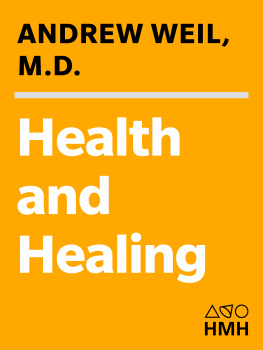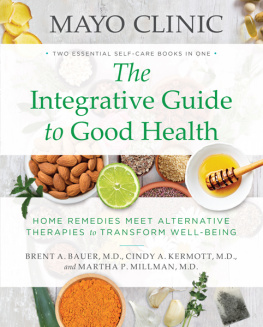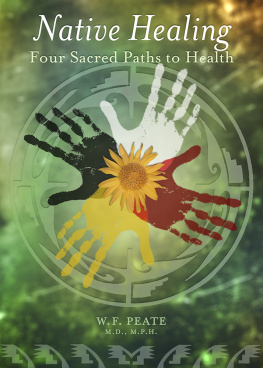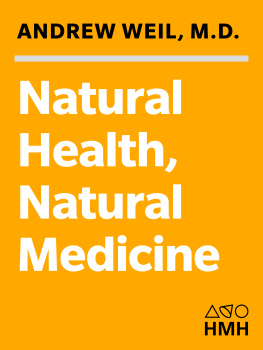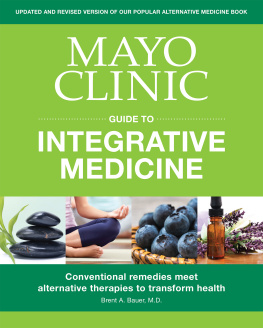Copyright 1983, 1988, 1995, 1998 by Andrew Weil
Preface copyright 2004 by Andrew Weil
ALL RIGHTS RESERVED
For information about permission to reproduce selections from this book, write to or to Permissions, Houghton Mifflin Harcourt Publishing Company, 3 Park Avenue, 19th Floor, New York, New York 10016.
www.hmhco.com
The Library of Congress has cataloged the print edition as follows:
Weil, Andrew. Health and Healing. Includes index
1. Therapeutic systems. 2. Medicine. 3. Health. I. Title
R 733 W 44 1983 615.5'3 83-10845
ISBN 0-395-34430-1
ISBN 0-618-47908-2 (pbk.)
e ISBN 978-0-547-52768-0
v3.0316
THIS BOOK IS NOT INTENDED TO BE A TOTAL REPLACEMENT FOR STANDARD (ALLOPATHIC) MEDICINE, WHICH HAS ITS PLACE IN THE DIAGNOSIS AND TREATMENT OF DISEASE. ANY UNUSUAL, PERSISTENT, OR SEVERE SYMPTOMS SHOULD BE EVALUATED BY A PHYSICIAN. THE NATURAL TREATMENTS SUGGESTED HERE, ALTHOUGH GENERALLY SAFER THAN PHARMACEUTICAL DRUGS, CAN AFFECT DIFFERENT PEOPLE DIFFERENTLY, OCCASIONALLY PRODUCING ADVERSE REACTIONS. IF A CONDITION FAILS TO RESPOND TO THESE TREATMENTS, YOU SHOULD CONSULT A PHYSICIAN TO SEE ABOUT ANOTHER COURSE OF ACTION. THE AUTHOR AND PUBLISHER DISCLAIM RESPONSIBILITY FOR ANY ADVERSE EFFECTS RESULTING DIRECTLY OR INDIRECTLY FROM INFORMATION CONTAINED IN THIS BOOK.
Acknowledgments
Much of the material in this book grew out of lectures given over the past several years in the Human Behavior and Development course at the College of Medicine of the University of Arizona in Tucson. I am grateful to the creators of that course, the late Dr. Shirley Nickols Fahey and the late Dr. Herbert Pollock, for giving me the incentive to organize my information about alternative treatment and my speculations on the importance of placebo responses.
Persons who helped me find facts and references I needed include Dana Ullman, Harris Coulter, Leif Zerkin, Dr. Fred Edwards, Dr. Gregory Manteuffel, Dr. Joseph Alpert, Dr. Guido Majno, Dr. Bernard Beitman, and Dr. Brian Becker.
Other people helped me by reading portions of the manuscript in its preliminary stages: Winifred Rosen, Willard Johnson, Steve Goehring, Woody Wickman, Sue Fleishman, Dr. Joseph Subasic.
Russell and Hope Williams gave me a place to write when I moved to California in the middle of working on the book. Kim Cliffton kept my energy and spirits up. The late Zig Schmitt helped me get settled on the East Coast when I left California.
Finally, I would like to thank Anita McClellan and Austin Olney of Houghton Mifflin and Lynn Nesbit of International Creative Management. Their steady interest in the book kept my own from flagging.
Preface to the 2004 Revised Edition
I NTEGRATIVE MEDICINE is now firmly established as a trend in America and around the world. At this writing, twenty-five North American medical schools have joined the Consortium of Academic Health Centers for Integrative Medicine, indicating a commitment to move teaching, research, and clinical practice in this direction. (For information on this group, see www.imconsortium.org.)
At the Program in Integrative Medicine (PIM), which I have directed at the University of Arizona for the past ten years, we define this field as follows: Integrative medicine is healing-oriented medicine that takes account of the whole person (body, mind, and spirit) as well as all aspects of lifestyle. It emphasizes the therapeutic relationship and makes use of all available therapies, both conventional and alternative.
Note that conventional and alternative (CAM) therapies are only one part of the definition. Integrative medicine has much broader goals than simply giving doctors new tools. It aims to re-focus medicine on health and healing rather than on disease and treatment, to restore the doctor-patient relationship that has so eroded in the present era of for-profit medicine, and to insist that human beings are more than physical bodies. Having worked to create this change in medical thinking and practice, I am gratified to see so many practitioners and institutions embracing it.
Health and Healing was the first book I wrote on these subjects. Originally published more than twenty years ago, it remains the philosophical basis of all my subsequent work in medicine. I still assign it as a text to medical students and give it as basic reading to doctors entering training at PIM. The most important ideas herein are that healing responses originate within us rather than without and that good medicine should always work from the premise that the body is capable of returning to a state of health. Over two thousand years ago, Hippocrates advised us to revere the healing power of nature; nonetheless, this simple principle is not currently taught in schools of conventional medicine.
At the time I wrote this book, I was lecturing to medical students at the University of Arizona about alternative medicine. It came as a surprise to them, and to most physicians, that what they were learning was one kind of medicine, called allopathic (or conventional or orthodox) medicine, but that was the case. In those days I was a rarity as a medical doctor who had studied the origins, theories, and practices of such other systems as homeopathy, osteopathy, chiropractic, naturopathy, and Chinese medicine.
Today CAM is widely available as a result of consumer demand, and more physicians are informed about it to one degree or another. The medical establishment only began to pay attention in the 1990s, as it was engulfed in economic catastrophe. Conventional medicine, now so dependent on technology, has simply become too expensive. No one can pay for it, the clients are less and less satisfied, and the health care system is collapsing around us. Physician unhappiness is also at an all-time high.
In this climate, integrative medicine looks more and more attractive. Clearly, it is the kind of medicine many, if not most, people want. It also has the potential to restore the core values of medicine that have been so diminished by managed care and to make the practice of medicine satisfying again. But I believe that what will really propel integrative medicine into the mainstream is economic analysis that will show it to be more cost-effective than conventional medicine. My colleagues and I are convinced that integrative treatment can produce outcomes as good as or better than those of conventional treatment for many common conditions at substantially lower cost. Of course, we need to do the research to prove that contention and take the data to those who pay for health care.
This book develops the philosophy of integrative medicine and of the kind of optimum health I urge you to pursue for yourself. I have added some new material to this edition and have gone through the text carefully to bring all the facts up to date. I hope Health and Healing will continue to be of interest and use to both practitioners and patients.
Vail, Arizona
September 2004
I
Treatment and Cure: The Strange Case of Homeopathy
A Homeopathic Cure?
I N F EBRUARY OF 1980, while on a business trip to Berkeley, California, I had a sudden attack of a pain I had never before experienced. It started in the center of my chest and eventually radiated to the center of my back, left shoulder, throat, and right lower jaw. The pain was steady, with a penetrating, boring quality. It was associated with a feeling of difficulty in swallowing, as if something were lodged in the very bottom of my esophagus. There were no other symptoms.
The first episode came out of the blue in the evening, two hours after eating a regular meal, when I was relaxing after a stressful day. The pain was unrelieved by drinking water, eating, or doing anything else simple I could think of. It lasted two hours, then subsided as I lay down to sleep. The next morning it was gone.
Next page
